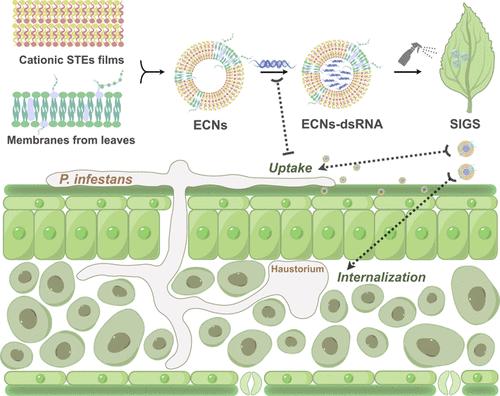Extracellular Vesicles Mimetic Design of Membrane Chimeric Nanovesicles for dsRNA Delivery in Spray-Induced Gene Silencing for Crop Protection
IF 15.8
1区 材料科学
Q1 CHEMISTRY, MULTIDISCIPLINARY
引用次数: 0
Abstract
Spray-induced gene silencing (SIGS) presents a promising RNA interference (RNAi)-based crop protection strategy against eukaryotic phytopathogens. However, the application of SIGS faces challenges, such as the limited uptake of dsRNA by certain pathogens and the instability of dsRNA in the environment. This study introduces innovative biomimetic nanovesicles, called extracellular vesicle (EV) mimetic chimeric nanovesicles (ECNs), assembled from tomato leaf cell membranes and cationic sterosomes via the freeze–thaw method. Similar to the function of EVs in nucleic acid transport between cells, ECNs serve as a hybrid nanosystem to overcome the challenge of delivering exogenous dsRNA in Phytophthora infestans. When applied to SIGS, the superiority of ECNs in crop protection becomes more apparent, including high loading and protection of dsRNA, improved biosafety, and efficient internalization into pathogen and plant cells, all of which significantly enhance the efficacy of RNAi in preventing early infection of P. infestans to susceptible tomato plants. This study demonstrates that ECNs are promising RNA delivery vehicles and will promote the use of SIGS-based RNA pesticides in sustainable agricultural production.

模仿细胞外囊泡设计膜嵌合纳米颗粒,用于喷洒诱导基因沉默中的dsRNA递送以保护农作物
喷雾诱导基因沉默(SIGS)是一种很有前景的基于 RNA 干扰(RNAi)的作物保护策略,可用于对抗真核植物病原体。然而,SIGS 的应用面临着挑战,例如某些病原体对 dsRNA 的吸收有限以及 dsRNA 在环境中的不稳定性。本研究介绍了一种创新的仿生物纳米囊泡,称为仿细胞外囊泡(EV)嵌合纳米囊泡(ECNs),由番茄叶细胞膜和阳离子固缩体通过冻融法组装而成。与 EV 在细胞间运输核酸的功能类似,ECNs 可作为一种混合纳米系统,用于克服在 Phytophthora infestans 中传递外源 dsRNA 的难题。当应用于 SIGS 时,ECNs 在作物保护方面的优越性更加明显,包括高负载和保护 dsRNA、提高生物安全性以及高效内化到病原体和植物细胞中,所有这些都显著提高了 RNAi 在防止 P. infestans 早期感染易感番茄植株方面的功效。这项研究表明,ECNs 是一种前景广阔的 RNA 运送载体,将促进基于 SIGS 的 RNA 杀虫剂在可持续农业生产中的应用。
本文章由计算机程序翻译,如有差异,请以英文原文为准。
求助全文
约1分钟内获得全文
求助全文
来源期刊

ACS Nano
工程技术-材料科学:综合
CiteScore
26.00
自引率
4.10%
发文量
1627
审稿时长
1.7 months
期刊介绍:
ACS Nano, published monthly, serves as an international forum for comprehensive articles on nanoscience and nanotechnology research at the intersections of chemistry, biology, materials science, physics, and engineering. The journal fosters communication among scientists in these communities, facilitating collaboration, new research opportunities, and advancements through discoveries. ACS Nano covers synthesis, assembly, characterization, theory, and simulation of nanostructures, nanobiotechnology, nanofabrication, methods and tools for nanoscience and nanotechnology, and self- and directed-assembly. Alongside original research articles, it offers thorough reviews, perspectives on cutting-edge research, and discussions envisioning the future of nanoscience and nanotechnology.
 求助内容:
求助内容: 应助结果提醒方式:
应助结果提醒方式:


